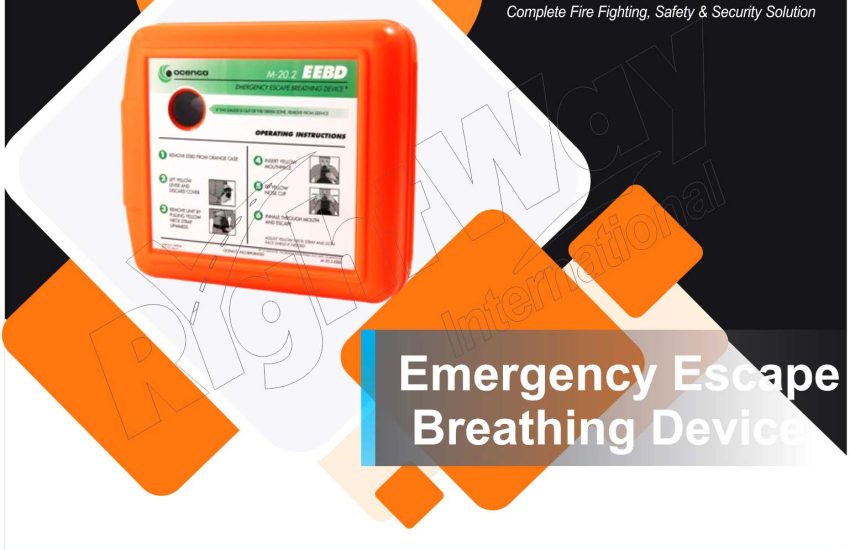Emergency Escape Breathing Device (EEBD) is a vital piece of safety equipment designed to provide short-term respiratory protection during emergencies. It enables individuals to evacuate quickly and safely from environments compromised by smoke, toxic gas, or insufficient oxygen.
1. Purpose and Importance of Emergency Escape Breathing Device
Immediate Respiratory Protection
An EEBD offers an instant supply of breathable air or oxygen. This is essential during emergencies when the surrounding atmosphere becomes hazardous due to contaminants.
Safe Evacuation
By supplying clean air, the device allows users to exit dangerous areas swiftly and safely, often guiding them through smoke-filled or gas-exposed paths.
Regulatory Compliance of Emergency Escape Breathing Device
EEBDs are engineered to meet safety regulations across industries, ensuring that employers and operators follow mandatory escape protocols in hazardous workplaces.
2. Key Components of an EEBD
Understanding the parts of an EEBD helps in both its use and maintenance:
Breathing Apparatus
The heart of the device, it includes:
- Facepiece or Hood: Covers the user’s face to ensure a tight seal and clear vision.
- Air Supply Unit: Delivers breathable air via a compressed air cylinder or chemical oxygen generator.
- Regulator: Manages the air flow, maintaining a steady and safe supply of oxygen.
Support Components
- Harness or Straps: Secure the device to the user for ease of movement.
- Carrying Case: Protects the EEBD and makes it easy to access in emergencies.
- Instruction Manual: Offers guidance on proper usage, inspection, and storage.
3. Types of Emergency Escape Breathing Device
EEBDs come in several forms, each suited to different scenarios:
Self-Contained Breathing Apparatus (SCBA)
SCBAs deliver breathable air from a compressed cylinder and are ideal in environments where outside air is completely unusable.
Escape Respirators
These devices often use chemical filters or oxygen-generating chemicals. They provide sufficient air for short evacuations and are lighter and more compact.
Emergency Oxygen Masks
Simple and portable, these offer a quick supply of oxygen from a small cylinder or chemical oxygen source, intended for brief, immediate use.
4. Common Applications
EEBDs are essential in various industries where air quality can rapidly deteriorate:
Industrial Facilities
Used in factories, refineries, and chemical plants where sudden releases of gas or toxic substances are a risk.
Maritime Environments
Ships and offshore platforms require EEBDs to help crew members escape fires or gas leaks safely.
Mining Operations
Miners rely on these devices to exit tunnels or shafts when ventilation fails or when dangerous gases are present.
Commercial Buildings
Buildings with fire or chemical hazards benefit from EEBDs to ensure safe evacuation for occupants.
5. Maintenance and Care
For EEBDs to function correctly in emergencies, consistent maintenance is essential:
Regular Inspections
Check for signs of wear, damage, or expired components. Make sure air supplies are full and facepieces are intact.
Proper Cleaning
Clean the facepiece and other components as instructed by the manufacturer. Avoid using aggressive chemicals that might degrade the materials.
Safe Storage
Store the device in a clean, dry area away from direct sunlight, dust, and extreme temperatures. It should be easy to access in an emergency.
Timely Replacement
Replace expired or damaged parts—especially the air supply and filters—to guarantee reliability during actual use.
6. Safety Considerations of Emergency Escape Breathing Device
To maximize safety and preparedness:
Comprehensive Training
All potential users must be trained in donning, operating, and removing the EEBD efficiently and quickly.
Routine Drills and Checks
Regularly conduct evacuation drills and perform device checks to ensure everyone is familiar with the equipment and that it’s functioning properly.
Regulatory Adherence
Follow all applicable local and international standards to ensure compliance and avoid fines or liability.
7. Regulatory Compliance of Emergency Escape Breathing Device
EEBDs must meet specific guidelines established by safety authorities, including:
- OSHA – Occupational Safety and Health Administration
- NIOSH – National Institute for Occupational Safety and Health
- CEN – European Committee for Standardization
- ANSI – American National Standards Institute
Compliance ensures the device performs reliably under real emergency conditions.
Conclusion
An Emergency Escape Breathing Device is more than a precaution—it’s a life-saving tool. By understanding its components, types, and proper maintenance, users can ensure they’re prepared to act swiftly and safely in emergencies. With regular inspections, correct usage, and strict adherence to safety standards, EEBDs remain a reliable part of any comprehensive safety strategy.


